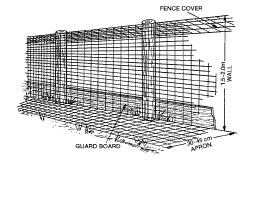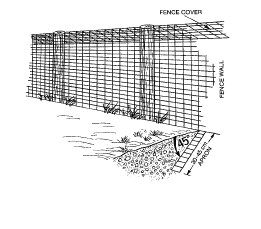| | Brooder house | Outside pens | Large enclosures
This publication is designed to help poultry producers reduce or prevent predation by improving or extending care and management of their flocks.
Most poultry predation occurs in flocks of 100 to 200 birds that are owned by small operators, who raise birds for home consumption or local sales. Large, commercial producers generally manage poultry under 100 per cent confinement and rarely experience predator losses. Ocassionally, large flocks are pastured and returned to overnight roosts where predation can occur. To qualify for assistance under Alberta's coyote predation management program, poultry must be adequately confined and managed to demonstrate appropriate protection.
Many poultry producers, particularly small scale operators, practise open range or unconfined management of their flocks. Unconfined flocks cannot be adequately protected from predation as birds are easy targets for predators and entire flocks can quickly disappear without apparent cause. Such practices are not recognized by the poultry industry and consequently ineligible for assistance under Alberta's coyote predation management program.
Prevention is the easiest and most effective method to control predation. A little extra time and effort spent protecting poultry will produce healthy, intact flocks at market time and the peace of mind knowing that predation is not a problem.
Brooder House
House the hatchlings and young birds in a completely enclosed and lockable building until they are 2 to 4 weeks old. At least twice a day, monitor the water, food, nesting provisions and temperature. Be sure all doors and windows close tightly and are locked when birds are inside, particularly at night.
Screen all ventilation ducts and windows with standard weight, 16 gauge (1.0 mm dia.) poultry wire that has a 1/2 in. (12 mm) mesh or use hardware cloth as the screening material. Floors, walls and ceilings should be inspected for holes or cracks and repaired with plywood or sheet metal before birds are placed inside.
Immediately remove dead birds and isolate ailing birds until they have completely recovered before returning them to the flock. Dispose of all dead birds by deep burial (3 ft) or complete burning.
Outside Pens
When birds are large enough to leave the brooder house, build an outside predator-proof pen attached to the brooder house, poultry barn, chicken coop or other adequate cover. The size of the pen is determined by flock size; three square feet per bird. For example, 100 birds should have a pen at least 30x10 ft (10x3 m) in area.
An 18 in. (45 cm) wide guard board, made from 1/4 in. (6 mm) plywood or heavy sheet metal, should be installed inside the pen around the bottom of the perimeter to protect the birds from wind. The guard will also keep the heads of the birds inside the pen and the predators out. Do not use square straw bales.
Pen walls should be made with standard weight 1/2 to1 in. (12-24 mm) wire mesh and measure 5 to 6 ft(1.5-2 m) in height. Be sure to place the wire 12 to 18 in. (30-45 cm) below ground level to keep birds in and predators out. You may build an "apron" outside the fence by laying a 12 to 18 in. wide wire mesh strip on the ground surface around the entire pen. Attach the apron to the fence and peg the apron down to keep predators from digging under (figure 1).

Figure 1. Apron fence (above ground).
Another apron design is to place the 12 to 18 In. wide mesh in the ground at a 45 angle to the ground surface. Attach this to the fence too and cover with soil (figure 2).

Figure 2. Angle apron fence (cover with dirt).
All outside pens should be completely covered with lightweight 20 gauge wire with a 1/2 in to 1 in.(12-24 mm) mesh. As an additional precaution, plastic ribbon streamers or pieces of metal flashing (use aluminum foil pastry dishes) can be attached to the cover mesh to keep birds of prey from attacking the poultry. Swooping birds may cause panic in poultry and serious injury or death to fleeing birds.
Another technique to repel birds of prey is a "shiny bottle."
Coat the inside of a dry, large clear-glass wine bottle with aluminum paint. Allow the paint to dry.
Turn the bottle upside down on a 15 ft (5 m) pole located next to the pen. Be sure the bottle is not obscured by tree branches or other objects. The aluminum paint creates reflections that frightens birds away.
For a 3000 ft pen, use 3 to 4 shiny bottles. Other, similar shaped objects such as the commercial 'coloured ball' are also an effective repellant for birds of prey. They can be mounted on a ploe or suspended from an overhead support. All visual repellants need to be clearly visible in all directions by potential invaders.
Prevent potential problems by removing all vegetation and debris around all enclosures. Mow the grass or treat it with herbicides to reduce the cover for predators.
To reduce the probability that birds may pile up when frightened, eliminate all corners in pens, brood houses and barns. Nail or attach, with heavy wire, triangular-shaped pieces of plywood board or sheet metal across the corners, so there are no right angles.
Large Enclosures
When larger fowl such as turkeys, geese and ducks are several weeks old, they may be relocated to larger enclosures or enclosures with water. Fences should be of the same configuration and height as outside pens; however, larger pens need not be covered.
Depending on the size of the birds, large mesh such as standard page wire with a 2 to 8 in. mesh should be used.
If coyotes are jumping over the fence, add one or two high tensile wires (12 1/2 gauge) above the page wire or construct a 90 overhand 6 to 18 in. (15-45 cm) wide. Use standard weight 1/2 to 1 in. poultry mesh for the overhang.
If coyotes are digging under the fence, add one electrified high tensile wire 6 in. (15 cm) above ground level, outside the fence (see Agdex 684-7 Protecting Livestock from Predation with Electric Fences.)
For more information on preventing and controlling coyote predation, see Agdex 684-19 Coyote Predation of Livestock.
Prepared by:
John Bourne
Vertebrate Pest Specialist
Vermilion
Source: Agdex 450/684-1. |
|